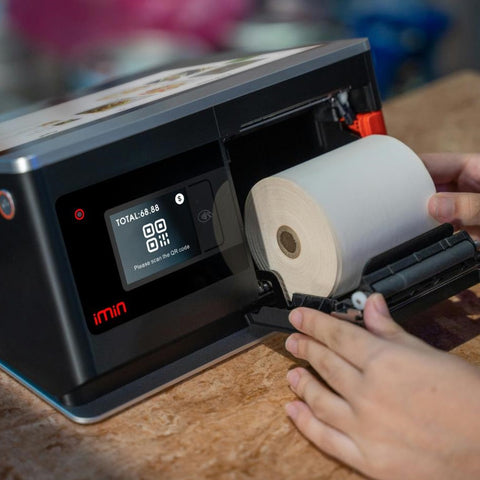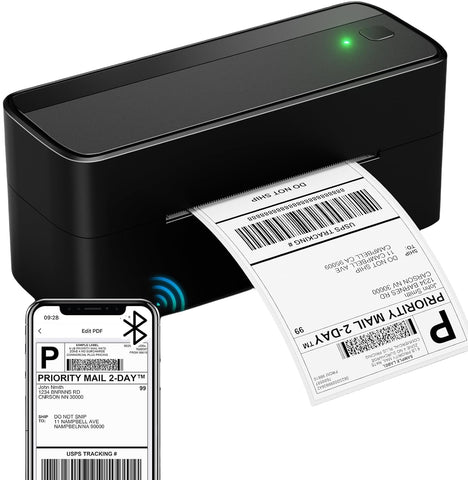What is Thermal Paper?
Thermal paper is a special type of paper that is coated with a chemical that changes color when exposed to heat. It doesn't require ink or toner to produce images or text; instead, the heat from a thermal print head activates the coating, creating the desired print. Thermal paper typically consists of several layers:
- Base Layer: The base layer is usually made of paper or plastic film. It provides the structural support for the thermal paper.
- Thermal Coating Layer: This layer contains a special coating composed of a mixture of dyes, developers, and other chemicals. When exposed to heat, this coating reacts by changing color, which forms the desired text or image. Different formulations of this coating can produce varying colors such as black, blue, or red.
- Protective Layer (Optional): Some thermal papers may have an additional protective layer on top of the thermal coating. This layer helps to protect the printed image or text from fading due to exposure to light, heat, or chemicals.
These layers work together to create the thermal printing process. When heat is applied to specific areas of the thermal paper by a thermal print head, the coating reacts, producing the desired text or image. Thermal paper is known for its simplicity and speed in printing, making it widely used in various applications.

What Are The Differences Between Thermal Paper and Normal Paper?
Thermal paper and normal paper differ in several aspects:
- Material and Coating: Thermal paper is coated with a special chemical layer designed to react with the print head to produce a heat reaction. This coating is crucial for thermal printing, eliminating the need for ink or toner. normal paper lacks this specific coating and is typically made from wood pulp or cellulose fibers, lacking the properties required for thermal printing.
- Thickness: Thermal paper is usually slightly thinner than normal paper to ensure effective contact with the coating and produce clear print results.
-
Cost: Due to the special coating and manufacturing process, thermal paper generally costs slightly more than normal paper.

Can I Use a Thermal Printer To Print Normal Paper?
Normal paper cannot be used in a thermal printer primarily due to the following reasons:
- Print Quality: Printing on normal paper in a thermal printer can result in blurry or unreadable printouts. Because normal paper lacks a thermal coating, the print head cannot generate the necessary heat reaction. This means that the printed text or images may appear blurry, unclear, or even unreadable.
- Potential Printer Damage: A thermal printer will attempt to heat a nonexistent coating on normal paper. This action may cause the print head to overheat or become damaged. Since the print head is a crucial component of a thermal printer, excessive heating or damage to it can affect the overall performance of the printer, potentially requiring repair or replacement.
- Paper Feed Issues: Thermal printers are typically designed to accommodate specific paper feed mechanisms for thermal paper. The size, thickness, and feed mechanism of normal paper may not match that of thermal paper, leading to paper jams or uneven feeding, thereby affecting print quality and the normal operation of the printer.
-
Consumables Cost: Using normal paper for printing may increase additional consumables costs, as ink or toner would be required. Thermal printers are designed to minimize consumables costs since they do not require ink or toner.

Applications of Thermal Paper
Thermal paper is suitable for scenarios requiring fast, clear, and temporary printing. Its convenience, efficiency, and cost-effectiveness make it widely popular in both commercial and personal settings:
- Receipt and Ticket Printing: Thermal paper is commonly used for printing receipts and tickets in retail stores, supermarkets, restaurants, gas stations, etc.
- Banking and Finance: Thermal printing technology is employed in banks, ATMs, self-service kiosks, etc., for printing transaction receipts, statements, and deposit confirmations.
- Healthcare Sector: Hospitals, clinics, pharmacies, etc., utilize thermal printers for printing prescriptions, medical reports, patient labels, and medication labels.
- Logistics and Transportation: The logistics and transportation industry relies on thermal paper for printing shipping labels, transport documents, courier receipts, and package labels.
- Hospitality and Tourism: Hotels, car rental companies, airlines, etc., employ thermal printing for generating room receipts, itinerary confirmations, boarding passes, luggage tags, etc.
- Entertainment and Events: Movie theaters, concert venues, sports stadiums, etc., utilize thermal printers for printing tickets, entry passes, and food/drink orders.
Choosing the best thermal paper is essential to meet your own needs, ensuring efficient and reliable printing results.
Summary
In summary, a thermal printer requires specially designed thermal paper to function properly. Normal paper is not suitable for this type of printer because it lacks the necessary thermal coating, which can result in poor print quality or even damage to the printer. Therefore, when purchasing and using a thermal printer, it is essential to choose the appropriate thermal paper to ensure printing quality and device longevity.












